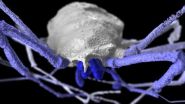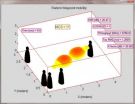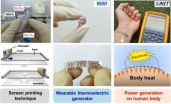(Press-News.org) (PHILADELPHIA) – Researchers at Penn Medicine have discovered that the tumor suppressor gene folliculin (FLCN) is essential to normal lung function in patients with the rare disease Birt-Hogg-Dube (BHD) syndrome, a genetic disorder that affects the lungs, skin and kidneys. Folliculin's absence or mutated state has a cascading effect that leads to deteriorated lung integrity and an impairment of lung function, as reported in their findings in the current issue of Cell Reports.
"We discovered that without normal FLCN the alveolar epithelial cells (AEC) in these patients' lungs began to die, leading to holes in the lungs that grow as increasing numbers of cells disappear. These holes can fill with air and burst, causing the lungs to collapse," says Vera Krymskaya, PhD, MBA, associate professor of Medicine at the Perelman School of Medicine at the University of Pennsylvania, and researcher in the Airway Biology Initiative of the department of Pulmonary, Allergy and Critical Care.
Between 80 and 100 percent of patients with BHD will develop multiple holes or cysts in the lung.
Healthy human alveoli, the terminal ends of the respiratory tree, are lined with type I and type II alveolar epithelial cells (AECs), a renewable population of progenitors in these distal airspaces. AECs are known to maintain pulmonary alveolar homeostasis by regulating gas exchange and fluid transport in the lungs.
Previous studies have shown that there might be some crosstalk between FLCN and the master energy sensor AMP-activated protein kinase (AMPK). AMPK maintains epithelial cell to cell interactions and is essential for epithelial cell survival. It is regulated through LKB1, a tumor suppressor gene associated with 30 percent of lung cancers. E-cadherin, the "zipper" molecule that connects epithelial cells, directs LKB1 to cell junctions and its loss impairs LKB1-mediated AMPK activation. This implies that a loss of or mutation in FLCN can trigger a reaction that can impair AMPK activation, epithelial cell to cell interaction and structure, and as a result, promotes cell death.
Penn researchers set out to examine this hypothesis to determine how and why this occurs.
Krymskaya and her team tested both deleted FLCN in mouse lung type II alveolar epithelial cells and mutated FLCN that lacked normal function in both humans with BHD and mouse epithelial cell systems, and compared them with normal human and mouse control cells.
The control cells showed normal epithelial structure, while the mutated FLCN cells showed irregular and disrupted lung cell structure. In addition, the BHD lungs showed very little FLCN in the type II alveolar epithelial cells.
Next, to evaluate the role of FLCN in the lung, the team isolated the alveolar epithelial cells from the mice with FLCN and deleted the gene in vitro to show the decreased cell to cell interactions and increased cellular permeability. They also examined activity of AMPK in these cells and saw that cells were dying without FLCN, so there was not proper activation of AMPK.
FLCN-deficient mice were also given a doxycycline supplement to conditionally delete FLCN specifically in alveolar epithelial type II cells both during embryonic development and as adults. Newborns experienced developmental changes induced by FLCN deletion in the lung epithelium. Over time, these morphed into changes that resembled emphysema, such as alveolar enlargement and a decline in lung elasticity and pulmonary function.
Further, the Penn researchers are the first to demonstrate the mechanism by which FLCN begins the domino effect necessary for normal lung function. Examination of cells with FLCN mutations shows that FLCN downregulates E-cadherin and LKB1 which controls AMPK activity. FLCN also maintains alveolar surface tension preventing the lungs from collapse, as seen in BHD disease. Without this, the lung changes associated with BHD and other common and rare lung diseases begin to appear: the abnormal enlargement of airspaces among them.
The team then showed that in fact, AMPK is necessary for epithelial cells survival. Importantly, using mouse BHD model, investigators show beneficial effect of pharmacological activator of AMPK AICAR, an AMPK stimulator, on lung function.
"AMPK is the metabolic regulator of the alveolar epithelial cells," says Krymskaya. "We may be able to reverse cell death if we can find a way to activate AMPK therapeutically in patients with less than optimal or mutated FLCN."
INFORMATION:
This project was supported by the NIH's Intramural Research Program, Frederick National Laboratory for Cancer Research and the Center for Cancer Research as well as the National Heart, Lung and Blood Institute R01 HL110551, and the Myrovyltis Trust.
Penn Medicine is one of the world's leading academic medical centers, dedicated to the related missions of medical education, biomedical research, and excellence in patient care. Penn Medicine consists of the Raymond and Ruth Perelman School of Medicine at the University of Pennsylvania (founded in 1765 as the nation's first medical school) and the University of Pennsylvania Health System, which together form a $4.3 billion enterprise.
The Perelman School of Medicine has been ranked among the top five medical schools in the United States for the past 17 years, according to U.S. News & World Report's survey of research-oriented medical schools. The School is consistently among the nation's top recipients of funding from the National Institutes of Health, with $392 million awarded in the 2013 fiscal year.
The University of Pennsylvania Health System's patient care facilities include: The Hospital of the University of Pennsylvania -- recognized as one of the nation's top "Honor Roll" hospitals by U.S. News & World Report; Penn Presbyterian Medical Center; Chester County Hospital; Penn Wissahickon Hospice; and Pennsylvania Hospital -- the nation's first hospital, founded in 1751. Additional affiliated inpatient care facilities and services throughout the Philadelphia region include Chestnut Hill Hospital and Good Shepherd Penn Partners, a partnership between Good Shepherd Rehabilitation Network and Penn Medicine.
Penn Medicine is committed to improving lives and health through a variety of community-based programs and activities. In fiscal year 2013, Penn Medicine provided $814 million to benefit our community.
Penn study finds mechanism that regulates lung function in disease Birt-Hogg-Dube syndrome
2014-04-10
ELSE PRESS RELEASES FROM THIS DATE:
Ancient 'spider' images reveal eye-opening secrets
2014-04-10
VIDEO:
This is a video showing the 305-million-year-old harvestman fossil.
Click here for more information.
Stunning images of a 305-million-year-old harvestman fossil reveal ancestors of the modern-day arachnids had two sets of eyes rather than one.
The researchers say their findings, published in the journal Current Biology, add significant detail to the evolutionary story of this diverse and highly successful group of arthropods, which are found on every continent except Antarctica.
University ...
Poor mimics can succeed as long as they mimic the right trait
2014-04-10
There are both perfect and imperfect mimics in nature. An imperfect mimic might have a different body shape, size or colour pattern arrangement compared to the species it mimics.
Researchers have long been puzzled by the way poor mimicry can still be effective in fooling predators not to attack. In the journal Current Biology, researchers from Stockholm University now present a novel solution to the question of imperfect mimicry.
Mimicry is when animals have the appearance of another species in order to avoid being attacked. For instance, hoverflies have a similar ...
Enzyme 'wrench' could be key to stronger, more effective antibiotics
2014-04-10
Builders and factory workers know that getting a job done right requires precision and specialized tools. The same is true when you're building antibiotic compounds at the molecular level. New findings from North Carolina State University may turn an enzyme that acts as a specialized "wrench" in antibiotic assembly into a set of wrenches that will allow for greater customization. By modifying this enzyme, scientists hope to be able to design and synthesize stronger, more adaptable antibiotics from less expensive, natural compounds.
Kirromycin is a commonly known antibiotic ...
NEJM: High-risk seniors surgery decisions should be patient-centered, & physician led
2014-04-10
Surgery for frail, senior citizen patients can be risky. A new patient-centered, team-based approach to deciding whether these high-risk patients will benefit from surgery is championed in an April 10 Perspective of the New England Journal of Medicine. The Perspective suggests that the decision to have surgery must balance the advantages and disadvantages of surgical and non-surgical treatment as well as the patient's values and goals in a team-based setting that includes the patient, his or her family, the surgeon, the primary care physician and the physician anesthesiologist.
One ...
Virus structure inspires novel understanding of onion-like carbon nanoparticles
2014-04-10
Symmetry is ubiquitous in the natural world. It occurs in gemstones and snowflakes and even in biology, an area typically associated with complexity and diversity. There are striking examples: the shapes of virus particles, such as those causing the common cold, are highly symmetrical and look like tiny footballs.
A research programme led by Reidun Twarock at the University of York, UK has developed new mathematical tools to better understand the implications of this high degree of symmetry in these systems. The group pioneered a mathematical theory that reveals unprecedented ...
New towns going up in developing nations pose major risk to the poor
2014-04-10
DENVER (April 10, 2014) – Satellite city projects across the developing world are putting an increasing number of poor people at risk to natural hazards and climate change, according to a new study from the University of Colorado Denver.
Throughout Asia, Africa and Latin America `new towns' are rapidly being built on the outskirts of major cities with the goal of relieving population pressures, according to study author Andrew Rumbach, PhD, assistant professor of planning and design at CU Denver's College of Architecture and Planning.
The towns often sit in high flood ...
Four-eyed daddy longlegs fossil fills in evolutionary tree
2014-04-10
Living harvestmen—a group of arachnids more commonly known as daddy longlegs—have a single pair of eyes that help them navigate habitats in every continent except Antarctica. But a newly described 305-million-year-old fossil found in eastern France shows that wasn't always the case. New research recently published in the journal Current Biology and led by scientists at the American Museum of Natural History and the University of Manchester indicates that primitive harvestmen had two pairs of eyes, adding significant details to the evolutionary story of this diverse and ...
New research on gigabit wireless communications
2014-04-10
Research on gigabit wireless communications has been presented by researchers from the University of Bristol at the world's leading wireless communications and networking conference, IEEE WCNC 2014, in Turkey earlier this week [Monday 6 to Wednesday 9 April].
The two research papers, led by Andrew Nix, Professor of Wireless Communication Systems and Dr Simon Armour, Senior Lecturer in Software Radio, from the University's Communication Systems and Networks research group in the Department of Electrical and Electronic Engineering, could have significant implications for ...
Thermoelectric generator on glass fabric for wearable electronic devices
2014-04-10
Wearable computers or devices have been hailed as the next generation of mobile electronic gadgets, from smart watches to smart glasses to smart pacemakers. For electronics to be worn by a user, they must be light, flexible, and equipped with a power source, which could be a portable, long-lasting battery or no battery at all but a generator. How to supply power in a stable and reliable manner is one of the most critical issues to commercialize wearable devices.
A team of KAIST researchers headed by Byung Jin Cho, a professor of electrical engineering, proposed a solution ...
Common sense health for young adult cancer survivors
2014-04-10
Many factors influence the life expectancy of childhood cancer survivors: not getting enough exercise, being underweight, and being worried about their future health or their health insurance. These are the findings of research led by Cheryl Cox of the St. Jude Children's Research Hospital in the US, published in Springer's Journal of Cancer Survivorship. The study found that, on average, childhood cancer survivors passed away before they were 40 years old.
Health-related behavior, self-perceived health status, and health concerns often influence mortality in the general ...




